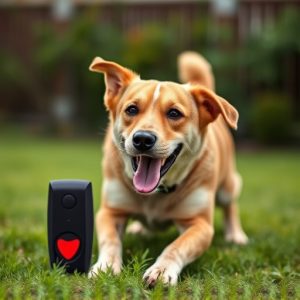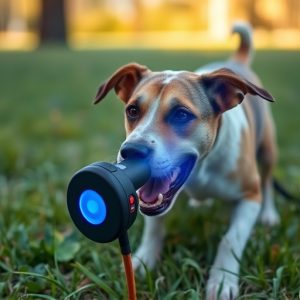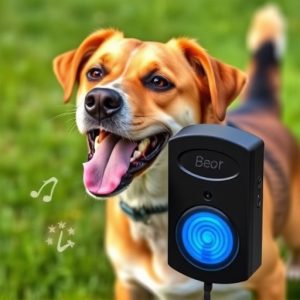Unleashing Safe Dog Behavior: Understanding Ultrasonic Repellents & EMC Certification
Dog repellent ultrasonic systems, leveraging high-frequency sound waves to modify canine behavior, r…….
Dog repellent ultrasonic systems, leveraging high-frequency sound waves to modify canine behavior, require stringent Electromagnetic Compatibility (EMC) certification to ensure safety and prevent signal interference. Proper certification involves rigorous testing for frequency range, power output, and performance, positioning these devices as humane alternatives to traditional repellents or punitive methods. Adhering to EMC Certification Requirements is vital for consumer trust, responsible innovation, and effective, safe canine behavior modification. While ultrasonic repellents show promise in addressing behaviors like barking or jumping, mixed scientific results underscore the importance of professional consultation before implementation.
“Unleash a safer, better-behaved pet with the power of canine behavior modification ultrasonic systems. These innovative devices offer a non-invasive approach to addressing unwanted behaviors by emitting high-frequency sound waves that remain inaudible to humans but can guide dogs away from triggering activities. In this article, we’ll explore how these systems work, delve into the essential EMC Certification requirements for such devices, and help you decide if ultrasonic repellents are the right choice for your furry companion.”
- Understanding Dog Repellent Ultrasonic Systems: How They Work
- EMC Certification for Canine Behavior Modification Devices: Unraveling the Requirements
- Benefits and Considerations: Are Ultrasonic Repellents Effective for Your Dog?
Understanding Dog Repellent Ultrasonic Systems: How They Work
Dog repellent ultrasonic systems are designed to modify canine behavior through the emission of high-frequency sound waves, typically beyond human hearing range. These devices operate on the principle that dogs have a more sensitive auditory system than humans, allowing them to perceive and react to sounds in ways we cannot. When activated, the system emits an ultrasonic signal that is unpleasant to dogs, encouraging them to avoid certain areas or behaviors.
The effectiveness of these systems relies on their ability to meet specific EMC (Electromagnetic Compatibility) certification requirements. This ensures that the ultrasonic signals do not interfere with other electronic devices and are safe for both dogs and humans. Proper certification involves rigorous testing to guarantee the system’s frequency range, power output, and overall performance comply with industry standards. By adhering to these guidelines, dog repellent ultrasonic systems offer a humane and environmentally friendly alternative to traditional repellents or punishment methods.
EMC Certification for Canine Behavior Modification Devices: Unraveling the Requirements
The electromagnetic compatibility (EMC) certification process plays a pivotal role in ensuring the safety and effectiveness of canine behavior modification devices, particularly those employing ultrasonic technology. These devices, designed to repel dogs through high-frequency sound waves, must adhere to stringent standards to prevent any adverse effects on both the animals and humans. The EMC Certification for Dog Repellent devices involves rigorous testing to ensure they do not emit harmful electromagnetic radiation and that their ultrasonic signals are targeted and non-intrusive.
The requirements delve into specific frequency ranges, power levels, and compatibility with other electronic equipment. Manufacturers must demonstrate that their products can operate without causing interference or damage to nearby devices. This certification process is crucial in gaining consumer trust and ensuring the responsible innovation of canine behavior modification systems. By adhering to these standards, developers can create effective, safe, and environmentally friendly solutions for managing dog behavior.
Benefits and Considerations: Are Ultrasonic Repellents Effective for Your Dog?
Ultrasonic systems designed for canine behavior modification offer a non-invasive and humane way to train dogs, making them a popular choice among pet owners. These devices emit high-frequency sound waves that are inaudible to humans but can be deterrents to dogs, helping to modify unwanted behaviors like barking or jumping. One of the key benefits is their safety; they do not cause physical harm or stress to the animal, ensuring a positive training experience.
However, when considering an ultrasonic dog repellent, it’s essential to understand its limitations and effectiveness. While many commercial products claim success, scientific studies show mixed results. The success rate heavily depends on the specific behavior, dog breed, and individual response. Additionally, factors like EMC Certification Requirements for electronic devices must be met to ensure safety and avoid potential health risks associated with incorrect use. Always consult a professional trainer or veterinarian before introducing any new training method, especially when dealing with sensitive canine behaviors.
Ultrasonic dog repellent systems offer a non-invasive and humane approach to modifying canine behavior. By understanding how these devices work and their effectiveness, pet owners can make informed decisions. Ensuring that any chosen device meets the stringent EMC certification requirements is crucial for safety and performance. In summary, while ultrasonic repelents can be beneficial, careful consideration of your dog’s needs and environment is essential before implementation.


